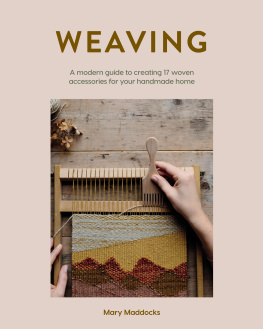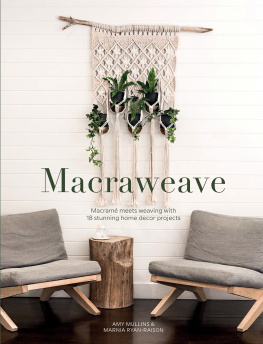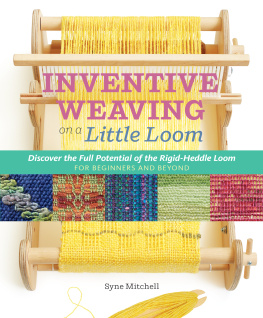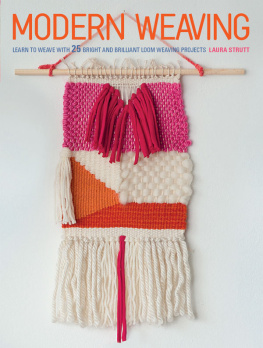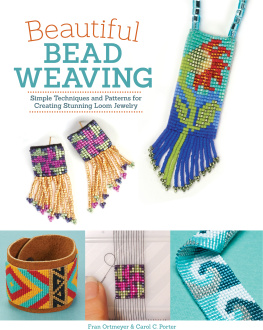A LITTLE THANK YOU...
I hope this book has inspired you to get weaving! As a little thank you, please use code WEAVINGBOOK to claim 20% off a place on one of my upcoming weaving workshops, or 10% off one of my weaving kits when purchased frommarymaddocks.com
I would like to say a huge thank you to everyone who has supported me and helped me to make this beautiful book. I am so grateful to you all.
Harriet, Nikki and the rest of the team at Quadrille, thank you so much for giving me the opportunity to write this book, for your encouragement, vision and patience, and for your belief in my work. It has been such a pleasurable experience to work with you, which is testament to your warm, humorous and gentle approach.
Maria, for your heavenly photos which exceeded all of my expectations, and for always bringing mood. Agathe, for your humour, impeccable styling and for tolerating my endless moving around of shells, twigs, balls of wool etc.
Thank you to all the weaving students I have had the pleasure to teach, learn from, hang out with and weave with over the last few years. Its been such a privilege to introduce new people to weaving and I am so grateful for your support and enthusiasm for this wonderful craft.
Thank you to my family and friends for all your support, encouragement and love from pre-weaving days to today.
Lon, for being the most loyal and loving of friends, I am so lucky to have you.
Mim, Faye, Cat and Laura, for all the years of nurturing friendship and laughter.
Melia, for your constant encouragement, inspiration and ideas.
Jack and D, for your company, creativity and love.
Helen, for your cheerleading and support.
Lynne for being a badass and reminding me I can be one too.
Rose, for being such a sweet friend when I really needed one.
Kate Rohde for your support and kindness.
Pauline, for your positivity and enthusiasm and all your help and support over the years.
Mum and Dad, for all your time, energy and love. For instilling in me a deep love of nature and being outside. For helping me to follow my passions. And of course for the many, many hours of babysitting!
Nen and Lu, for being my oldest and dearest friends in the whole world.
Raoul, for all your help, advice, love and encouragement over the years. For supporting me in taking the leap into a more creative life. Thank you.
And finally, to Nye. You are a total babe and, quite simply, my reason for everything. I love you.
Weaving is an ancient craft. Evidence suggests that humans began to weave cloth during the Neolithic era, about 12,000 years ago, and fragments of ancient woven cloth have been found all over the world, from Egypt to Peru, China to Switzerland. Even before we started weaving cloth, it is thought that our ancestors used simple weaving techniques to interlace leaves, twigs, grasses and branches to fashion tools and shelters for themselves.
I have been lucky to teach many people to weave over the last few years, and something I have observed time and time again is the apparently ingrained instinct that we seem to have for joining warp and weft. As soon as my students have a loom in front of them and a length of yarn in their hands, intuition takes over. Very little instruction is needed for them to understand how to combine warp and weft. Even young children are able, with minimal input, to thread weft yarn in and out of warp, interlacing the two and watching their weaving grow, row on row, as if by magic. The more I weave, and the more I teach others to weave, the more I wonder whether, in fact, we have inherited some ancient instinct to weave from our distant ancestors that is, by now, part of our nature.
My own introduction to weaving took place in school when my art teacher brought in her small table loom and taught me how to create a thin section of cloth on it. I was a clothes and textiles-obsessed 16-year-old and I fell in love with that loom as soon as I learnt to master it it was old and cranky, but I was transfixed by what it could produce when treated gently and patiently. I set about weaving a scarf of technicolour cloth so heavily adorned with ribbons, feathers and beads that by the time it came off the loom, it was far too heavy to wear around my neck. Instead, I painstakingly sewed it between two outer panels of tie-dyed silk, and it became the central panel of a garment I rather pretentiously described as a modern ceremonial cloak.
After I left school I put any artistic pretensions I may have had to one side, studying languages and philosophy at university and then drifting somewhat unthinkingly into an all-consuming legal career that took up most of my time for the next five years. I completely neglected any sort of creativity and although I worked hard, I couldnt help feeling that something was missing. And then one day the realization dawned on me that I desperately missed the act of creating things with my hands and needed to find time in my life to start making once again. Recalling my school days of weaving, I bought a simple frame loom and some second-hand wool on a whim and spent the next few months teaching myself to weave, using what I could glean from the limited number of online tutorials and videos that existed back then.
I was immediately enchanted by the simplicity of frame loom weaving, and the fact that there were very few rules and endless possibilities. I loved the rhythmic act of warping up my loom and the huge range and choice of weft. I loved the feel of combining the two, and the challenge of creating texture and depth. I loved using materials like wool, silks and ribbon to create objects that recalled the natural scenes that I cherished and the challenge of applying those materials to re-create the natural world. Very soon I was completely hooked.
My first weavings were littered with mistakes and strange design choices, but I loved them regardless. Each finished weaving spurred me on to create another, and with each new weaving I learnt a little more, developed my style a little more, and fell in love a little more. I spent every evening weaving, I weaved in bed, I weaved during car journeys and in front of every film and TV programme (I still do). As time went on I began selling my weavings and people started to ask me to teach them to weave too. My new hobby developed into a petite but incredibly rewarding business, of which I am very proud. Weaving allowed me to rediscover my creative impulse and, in turn, to understand myself a little better too.
I recently dug out that woven ceremonial cloak and was astonished by how colourful and bold it is, so far from my aesthetic leanings these days. Nonetheless, I see many influences in it that are still relevant to my work now the colours and patterns of natural artefacts such as shells, feathers, leaves. Holding it in my hands made me remember acutely the sensation of pure pleasure I felt sitting and weaving it at the loom, and the singular satisfaction of seeing it finished and whole. I was reminded again of the intense and addictive nature of the creative impulse, an impulse which I forgot about for a long time, but which, thankfully, was just lying dormant, ready to be ignited again when the time was right.
Many people I have spoken to over the last few years, especially in the corporate world, tell me that they are not creative and that they are no good at making things. It makes me so sad to hear that. I believe that the drive to create is within all humans and that nurturing that drive and enabling it to flourish can open the door to great joy, satisfaction and wellbeing. It doesnt matter what you create or even how well you create it, only that you carve out some time to make something, that you give yourself over to and allow it to absorb and engage you.

